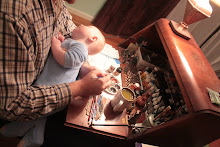Travel is one of the areas of DnD that is least understood, because few of us have traveled to distant locations on foot, or by horseback. In this day and age of cars, fast trains, and faster jet planes, the amount of time that it takes to walk from point A to point B is not understood on an intuitive level. Consequently all of the various rules for overland travel give very high rates of progress, and have very few encounters per day, particularly when one considers the amount of territory crossed.
One way to handle the issue of too much distance covered is to reduce standard travel to, say 8 hours a day, so 8 leagues, or ~24 miles. [thank you Talysman for pointing out my error here] Pressed travel rates would be more hours per day, as you really can not hike much faster, but could do so for longer. Horses would allow for slightly faster travel, but not if heavily loaded, and not for more than the 8 hours without running the risk of killing the horses over more than one day of travel.
A way to handle the second issue is to increase the frequency of encounters, while at the same time making more of them non-combat related. Mixing in some mundane encounters like "peasants" or "attractive local features" allows for more creative descriptions and role play potential than "a hex of woods, no encounter" ever would allow for.
Telecanter has another way to deal with the tedium of travel, by making the upkeep and wear and tear into a sort of mini game, where the travel itself causes a sort of damage that needs to be allocated to the various aspects of travel, i.e. animals, gear, supplies. Traveling through areas like swamps, or desert, or in the winter cold would create more damage points, which then need to be allocated to the animals and gear until they are used up/die etc. Resting in good terrain for extended periods "heals" some of the damage.
I personally have been backpacking several times before, and it is amazing what adding a bit of altitude, 40 pounds of equipment, and reducing the amount of oxygen available will do to your endurance and your perception of the amount of ground covered. Walking as the only means of transportation, and having to lug a hauberk, sword, and a bundle of torches to the scary cave from which no man has returned... well, that would be pretty hard on the old body.
On another note, my friends from back east are going to be in town for a week or so, and there was talk of running a game which has me thinking about deep dark places in the earth, and what creepy things may be found there. I have been looking over real-life tomb maps, and it is easy to imagine how a few pit traps, animated skeletons, or falling ceilings could make them into death traps. Great risk for a possible great reward... sounds like a fun session to me, so we will see how it goes.
Tuesday, May 15, 2012
Subscribe to:
Post Comments (Atom)


7 comments:
8 leagues would be anywhere from 20 to 24 miles, depending on which value of league you use. You may have meant 5-6 hours (leagues,) which seems to be what the original books use as base travel time. I figure the actual travel time is about 8 hours a day, but time has to be allotted for rest breaks or backtracking when a particular route turns out to be impassable.
I don't drive and don't have a bike, so a lot of my non-bus travel is on foot. I can barely do a 2 1/2 mile league in an hour, but I'm pretty out of shape. The slower LBB travel rates seem reasonable to me, compared to some of the later editions with their 30 miles per day (or higher!) travel rates.
Doh!
You are correct, I meant 24 miles, not 15, for some reason that got stuck in my head.
And you are brave to trust to bus/foot in this town, particularly considering fickle RT.
I've always used 24 mile hexes for travel. But making it interesting, that's hard. I find it easier at the table, but not as fulfilling when played on-line.
I haven't had many problems with RT being late all that often... it's the lack of service in some areas or times that's a much bigger problem for me.
I think it's reasonable to imagine, because they did not have cars or refrigerators or La-Z-Boys, ancient peoples (and by extension fantasy adventurers) were a bit more rugged than we today and could march out a 20 mile day and still have plenty of pep for a melee at the end of it.
The appropriate measure might be what a Roman foot soldier might accomplish... and that was an amazing thing, since at the end of the day's travel they also dug ditches and erected palisades.
Might be more productive to assign "intent" to the day's travel, whether a leisurely pace (in which case all players would enter random encounters rested) or at a forced march (in which case they might suffer some fatigue).
@Talysman
Years ago now, I rode a morning RT bus to lightrail, and then downtown. At least once a week it was late and at least once never showed.
@Pat Henry Roman soldiers were pretty amazing, although they were also amazing to others of that period.
Your point about "intent" is a good one, a slight reduction in travel time can have a large impact on fatigue, but sometimes you just need to get somewhere at a certain time.
Post a Comment